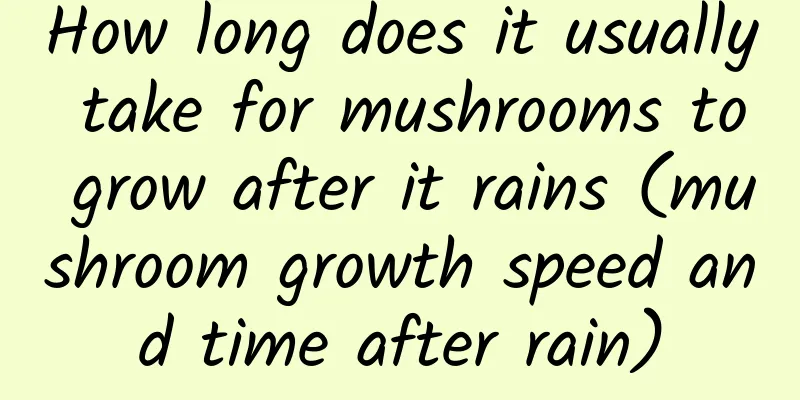How many days does it take for vegetables to germinate in this season?

|
Autumn is a suitable season for growing vegetables . At this time, the high temperature of summer gradually recedes, and the cool autumn breeze brings suitable temperature and humidity, providing a good environment for the growth of vegetables. So how many days does it take for vegetables to germinate in this season? Let’s learn more about it below. How many days does it take for vegetables to germinate in this season? The germination time of vegetable seeds is affected by many factors, including seed type, soil temperature, humidity, light conditions, etc. Generally speaking, different types of vegetable seeds have different germination times. for example: 1. Leafy vegetable seeds (spinach, lettuce, rapeseed, etc.): 5-7 days. 2. Root vegetable seeds ( carrots , beets, celery, etc.): 7-10 days. 3. Legume seeds (peas, broad beans , etc.): 10-14 days. 4. Melon and fruit seeds (cucumber, pumpkin, etc.): 7-10 days. 5. Onion and garlic seeds: 7-10 days. How to improve the germination rate of vegetable seeds? 1. Selecting improved varieties Choose seeds with full grains and high germination ability, and give priority to purchasing seeds from well-known brands and reputable suppliers to ensure that the seeds are fresh and not expired. 2. Seed treatment (1) Soaking: Soaking the seeds in warm water for several hours or overnight can soften the seed coat and promote germination. (2) Germination: Place the seeds on a moist paper towel or gauze, put them in a sealed bag, and place them in a warm place (about 20-25°C) for germination. (3) Disinfection: Treat seeds with diluted bleach or other seed disinfectants to reduce the risk of bacterial infection. 3. Environmental Control (1) Temperature: Different vegetable seeds have different temperature requirements. Generally speaking, most vegetable seeds germinate best at temperatures between 20-30°C. Temperature can be controlled using a greenhouse, nursery boxes, or heating mats. (2) Humidity: Keep the soil moist but not too wet, and avoid waterlogging. You can use a watering can to water lightly to keep the soil surface moist. (3) Light: Seeds can be divided into light-requiring and light-averse types. Light-demanding seeds require a certain amount of light for germination, while photophobic seeds can only germinate in the absence of light. 4. Sowing depth Planting depth also affects seed germination rate. Generally speaking, the sowing depth of seeds should be 2-3 times the diameter of the seeds. In general, each vegetable seed has different characteristics and its specific germination time is also different. But if you plan to grow vegetables this season, be careful to choose the right types of vegetables and ensure that suitable temperature, humidity and light conditions are provided to promote rapid germination of seeds.
|
<<: How many days does it usually take for corn to sprout after sowing?
>>: When is the best time to sow onions?
Recommend
How to grow Lingying succulent
1. Breeding environment 1. Soil: When growing Lin...
How to sow morning glory
Prepare the Materials The first choice is to have...
What flowers can't be watered with beer?
1. What flowers cannot Generally, there are no fl...
Are golden marbles poisonous? Can they be eaten?
Are gold marbles poisonous? It must be made clear...
Things to note when transplanting peach trees
1. Transplanting time The best time to transplant...
How to make redbud bloom on New Year's Day
Secret 1: Illumination It likes light. Except for...
Eel farming technology and management
Eel looks like a long snake. It is a fish with ri...
Can purple bamboo be hydroponically cultivated? Is hydroponics better or soil cultivation better?
Can purple bamboo be hydroponically cultivated? P...
The correct way to change the pot and soil of Bougainvillea
After caring for bougainvillea for a few years, m...
Can Milan be pruned? When is the best time to prune?
Milan pruning Milan can be pruned, and the prunin...
How many years does it take for a fruit tree to bear fruit?
Introduction to Planting Fruit Trees Various frui...
How to propagate arrowroot? Propagation methods and precautions
How to propagate arrowroot Common methods of prop...
Cultivation methods and precautions of yellow bract arrowroot
1. Maintenance methods 1. Temperature: Caladium g...
The reproduction method of black rice
Propagation and development by cuttings The cutti...
Which bonsai has the most beautiful flowers?
1. Daphne odora Its flowers are lavender in color...









